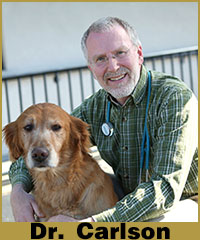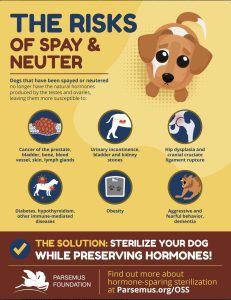Ovary-Sparing Spay – A Holistic Option for Your Pet’s Health

Joe Shuman/For MM
Hello pet parents, I’m Dr. Jim Carlson, a holistic veterinarian. I was the first veterinarian to perform ovary sparing spay in Illinois and Ohio. I’m happy to bring it to holistically minded owners. . Let’s start by discussing the traditional early spay and neuter procedures and their potential drawbacks.
The Drawbacks of Traditional Early Spay and Neuter Procedures
Traditional spaying involves removing both the ovaries and uterus in female animals. While this procedure effectively prevents pregnancies, it also disrupts the pet’s natural hormone production. Research suggests that early spaying can increase the risk of health problems such as bone cancer, obesity, urinary incontinence, and even behavioral issues.
The Benefits of Ovary-Sparing Spay
Ovary-sparing spay is an alternative to traditional spaying that preserves the ovaries and therefore the natural hormone production. By maintaining hormonal balance, this procedure can reduce the risk of the health problems associated with early spaying.
Additionally, ovary-sparing spay offers joint protection, which can be particularly beneficial for certain breeds prone to hip dysplasia and other joint issues. It’s also been suggested that leaving the ovaries can reduce the risk of certain types of cancers.
Ovary Sparing Spay Handout  Weighing the Pros and Cons of Ovary-Sparing Spay
Weighing the Pros and Cons of Ovary-Sparing Spay
While ovary-sparing spay has several benefits, it’s important to understand the potential downsides. This procedure is more complex and thus may come with a higher cost. Additionally, pets will continue to experience heat cycles with no bleeding, and there’s a slight risk of pyometra, a serious uterine infection.
It’s crucial to monitor your pets closely for any signs of reproductive issues. Regular vet visits and open communication with your vet are key to mitigating these risks. 
Photo by Hannah Grace on Unsplash
Waiting to Spay: A Consideration
I encourage pet owners to consider waiting until their pets are fully grown before spaying. Delaying the procedure allows the pet to utilize its natural hormones, which can contribute to overall health and longevity. Here’s a guide to help you understand it better.
Working with Your Veterinarian
Choosing when and how to spay your pet is a decision best made with your veterinarian. They can provide guidance based on your pet’s breed, age, health status, and lifestyle. Remember, every pet is unique, and what works best for one might not be the best for another. For more information, please visit the Parsemus Foundation.
As we navigate this journey together, my team and I are here to support you and your furry family members. Just reach out to us via the website. After all, our goal is the same – ensuring the happiest, healthiest life possible for your pet.

